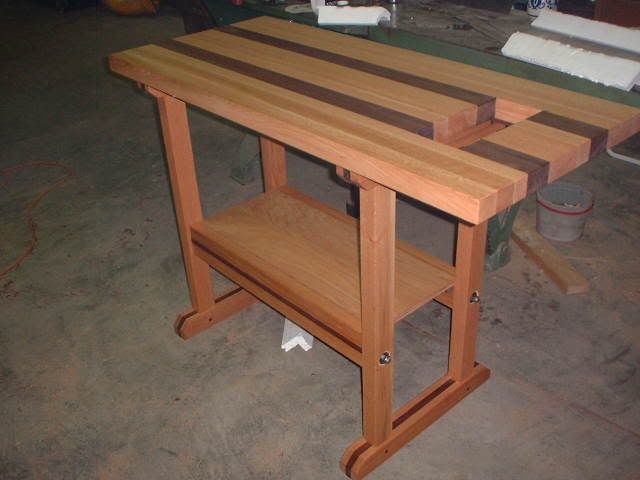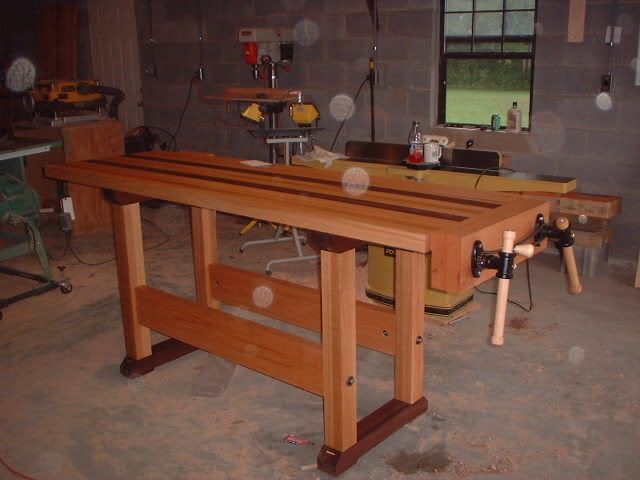Everyone,
Wow! Thanks so much for the time you took to help out here. Even though I've done large cutting boards and portable butcher blocks many times, for some reason this project made me pause. After all, this will become the kitchen counter top, so I need to make sure there are no hidden details I'm missing. You have all helped me feel more confident with the main steps and procedures.
Listening to all of you, it seems that the general consensus is that bolts or other mechanical fasteners are not necessary, especially when doing 1.5" face-grain glue-ups. But again, it was good to hear from people who have done this, so I can be sure.
The one area where there is still a lot of variation is in finishing. But that's all right, since it seems that all of the options mentioned here can work well.
Lou,
I ended up getting 8/4 hard maple from my local wood dealer. Spent about two hours picking out the right slabs and in the end got what I needed. I only have a 6" jointer and a 13" planer, but the basic process you describe will work in my situation! For sure, I'll be using my Rotex for this job. Funny you mention the Besseys and Jorgensens, because I have slowly been changing all my clamps over to pipe versions. Like a lot of learning woodworkers, I went through stages where I tried all sorts of clamps. In the end, I came back to the "simpler is better" mode in this area of woodworking. I've purchased numerous lengths of pipe from Home Depot, and have something like 12 or 14 Pony pipe-clamp mechanisms (the kind you don't need to screw the pipe into). So much better! When doing glue-ups on cauls, I went back to the simple C-clamps (large ones) or those other simple clamps whose name I now forget that are essentially pipe clamps with rubber heads.
Dave,
Finishing was going to be my next question, but you covered that! Some other people mentioned finishing techniques, but for some reason I am partial to your suggestion to use Danish oil and polyurethane to finish the butcher-block counter top. You really got me thinking about all the possible edging options, and it didn't take me long to start imagining all the great ideas I could employ here, as mentioned in your post! However, my wife likes the plain-edge look of the glued-up blocks, so I'll go with that. But I've got several other projects to do in other areas of the kitchen and the house, so I will revisit your edging suggestions again in the future. In the meantime, your ideas should certainly be helpful to other people doing similar projects, so I'm glad they are recorded here.
Jesse,
I've long wanted to build some kind of router sled that could do planing the way you describe. I've mentioned this in the old Yahoo forum. I've seen jigs that help with this, but my interest would be to create something using Festool items. I've sometimes wondered whether the MFS might somehow be an element to a system like this. With the size and weight of the butcher-block tops, it does seem like the perfect project to address this idea.
Mike,
Thanks for adding your voice to the "don't need bolts" view. I'm glad to hear it, since I would rather not have to do that! And I hear what you're saying about the planer. When I plane smaller end-grain cutting boards, I usually take off very slight amounts with each pass, or I run them through the planer at an angle, or both. What a nightmare it would be to get tearout in something like this!! I'm hoping that with the Rotex, I can reduce the amount of planing necessary for the sections of butcher block. Unfortunately, I don't have access to a school planer, so my own planer (a Dewalt 13") would have to do all the suffering!
Burt,
Thanks for sharing your skill as a woodworker, which I know is considerable. I don't have a wide-belt sander, though I've been considering one for some time. This is a big project, and will make a huge improvement to one of the main rooms in the house. It's also the room where my wife, who's a serious cook, has a lot of fun and pride entertaining our guests. So perhaps this is the project to make my case for a new major machine like a wide-belt sander!
Again, thanks to everyone for your time and energy helping out here.
Stay in touch,
Matthew Schenker


